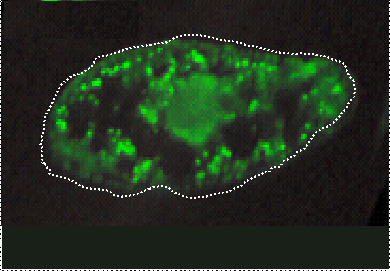Tetrahymena
Tetrahymena is a eukaryotic, ciliated protozoon used as a model cell in a wide range of investigation in cell physiology, molecular biology and molecular genetics. In our experiments the most frequently used taxon is Tetrahymena pyriformis GL, however we gained data about T. pyriformis (Zeuthen), T. thermophyla, T. pigmentosa, T. Hegewishi, T. Malaccensis, T. Shapiro, T. MS-1, T-CU 399.
Suitability of this model is supported by several theoretical and practical evidences:
Theoretical
- it has adequate membrane receptors to higher ranked vertebrates (e.g. insulin receptor)
- second messenger systems (e.g. cAMP, cGMP, IP3, Ca2+-calmodulin) are analogue to vertebrates
- cell physiological responses are induced similarly to vertebrate (human) models
- several endogenous regulatory substances (e.g. insulin, relaxin, IL-6, melatonin) are produced/released which point to that the auto- and paracrine activity of these cells is also homologue to multicellular organisms

Confocal microscopy image of FITC-insulin binding in Tetrahymena
Practical
- relatively short cell cycle (~150 hrs) provides easy follow-up studies of hundreds of generations
- it is easy to reach and control a standard concentration of substances used in treatments
- sterile handling of cultures is easy
Chemotaxis
Tetrahymena is basically a free living cell, sweet water of ponds is its natural environment. Chemotaxis is one of the most physiological responses of Tetrahymena cells. As a unicellular organism it is essential to sense a relatively wide range of molecules of the environment and to distinguish beneficial signals (e.g. nutrients) from hazardous ones.
Tetrahymena has a high sensitivity to sense and differentiate small and large molecules alike. Even slight structural alterations of the molecules are detected by these cells:
-
crystalline or amorphous forms of the same insulin derivative
-
physicochemical characteristics of peptide ligands (e.g. values of surface exposed area-SEA or pKa)
-
truncation of the molecule (e.g. bradykinins)
-
mirror variants of peptides (e.g. X-Pro and Pro-X dipeptides)
-
amidation of C-terminus in the peptide (e.g. WSXWS peptides)
(see References: 2, 39, 28, 14, 34)
In our laboratory investigations of Tetrahymena have started 30 years ago. Prof. Csaba, G. (former head of the Department) prompted to apply the organism as a model for study receptor phylogeny and ontogeny. In these works Tetrahymena was used as a very fundamental model.
Data of the last three decades are collected in databases with short comments in the Archives.